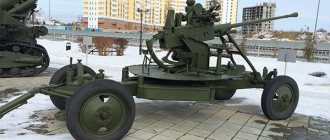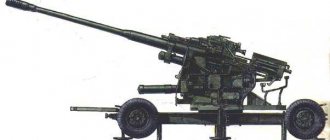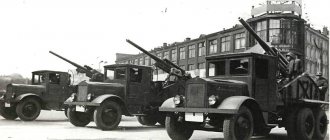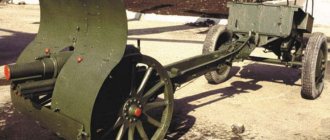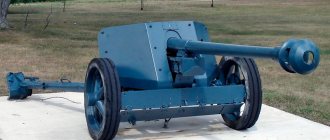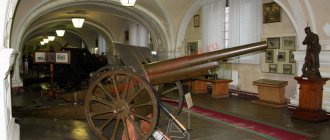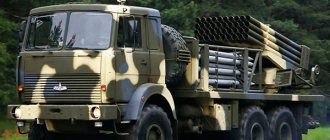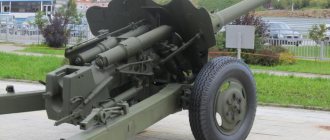The history of the creation of the 85-mm anti-aircraft gun "52-K"
The 85-mm anti-aircraft gun model 1939 (“52-K”) was developed at the design bureau of the M.I. Kalinin plant in 1939, under the leadership of Mikhail Nikolaevich Loginov. The choice of a sufficiently large caliber for anti-aircraft artillery, as well as the extremely short time allotted for completing the task of the Main Artillery Directorate (GAU), was determined by the rapid increase in the power of aircraft engines and, as a result, a significant increase in the flight altitude of bombers of the most likely enemies.
To speed up the work, according to the design of engineer and lead designer G.D. Dorokhin, the design was based on an earlier development by the same Loginov - a 76-mm anti-aircraft gun mod. 1938. But it was G.D. Dorokhin who proposed to put a new 85-mm barrel on the platform of the 76-mm anti-aircraft gun mod. 1938, also using its bolt and semi-automatic action. The result was an artillery system of amazing power and reliability, which for many years to come eliminated the need for air defense troops in medium-caliber anti-aircraft artillery.
In the same year, 1939, a new 85-mm anti-aircraft gun with the factory designation 52-K underwent field tests, during which the need to install a muzzle brake, increase the supporting surface of the bolt wedge and the breech socket was revealed. The weapon, modified in accordance with the recommendations of the scientific testing site, was adopted by the Red Army in the fall under the name “ 85-mm anti-aircraft gun mod. 1939. "
An important feature of the new anti-aircraft gun was its versatility: the 52-K was suitable not only for firing at enemy aircraft, but was also successfully used as an anti-tank weapon, firing at enemy armored vehicles with direct fire. It was this remarkable quality that opened up another role in the combat career of the 85-mm anti-aircraft gun: the 52-K gun served as the basis for the creation of the D-5 and ZIS-S-53 tank guns, which were subsequently installed on the SU-85 self-propelled guns and T- tanks 34-85, KV-85 and IS-1.
In total, for the period from 1939 to 1945. USSR industry produced 14,422 52-K guns. After being removed from service at home, the gun was widely supplied abroad.
It is quite simple to distinguish the 85-mm anti-aircraft gun of the 1939 model 52-K from the earlier 76-mm anti-aircraft gun of the 1938 model: the latter was not equipped with a muzzle brake
Design
In the USSR Navy, in order to increase the air defense of ships in the interwar years, the 76.2-mm artillery mounts (AU) of the first generation were modernized. It was decided to switch to a larger 85 mm caliber. 85-mm barrels of standard army guns were installed on the 76-mm gun mounts, preserving all the other main elements of the ship's mounts.
Installation 92-K
85 mm universal deck installation mod. 1941 90-K was designed in the design bureau of plant No. 8 and was an improved version of the 76-mm AU 34-K with a swinging part from the 85-mm army anti-aircraft gun mod. 1939
Operation and combat use of the 85-mm anti-aircraft gun "52-K"
85-mm anti-aircraft gun mod. 1939 "52-K" was extremely widely used by units of the Red Army both during the war and, having undergone a series of successive modernizations, right up to the time when anti-aircraft guns in the USSR troops replaced anti-aircraft missiles.
During the Great Patriotic War, units of these guns provided both air defense of front-line units and air defense of administrative centers and industrial enterprises. Organizationally, the 52-K was in service with the anti-aircraft artillery divisions of the RVGK, consisting of three regiments of small-caliber anti-aircraft artillery and one regiment of medium-caliber guns (sixteen 85-mm cannons and forty-eight 37-mm cannons).
In general, during the war, out of 21,645 enemy aircraft shot down by ground-based air defense systems, medium-caliber anti-aircraft artillery (mostly 85-mm cannons) accounted for 4,047 aircraft. The average consumption of shells per shot down aircraft was 598 pieces.
A significant part of the 85-mm anti-aircraft guns were used as anti-tank guns. For example, according to the 1940 state, each of the 10 anti-tank artillery brigades formed before the war should have, among other guns, twenty-four 85-mm anti-aircraft guns used as anti-tank guns. In fact, due to the slow development of production of 107-mm guns, which were also supposed to arm these brigades, the number of 85-mm guns in them was 48 units or more. Armed with 85 mm anti-aircraft guns, the anti-tank division was the standard combat unit of every tank and mechanized corps of the Red Army for almost the entire war.
An interesting fact: upon removal from service, only the “combat career” of the 85-mm anti-aircraft gun model 1939 ceased, but the “peaceful career” of this weapon continues in our time. The fact is that the guns used in mountainous areas as anti-avalanche guns, shooting down tons of snow from mountain peaks, are still the same 52-K.
Bibliography[edit]
- Hogg, Ian (2000). Artillery of the 20th century
. Friedman/Fairfax Publishers. ISBN 1-58663-299-X. - Jane's Armor and Artillery
(1982). Jane Publishing Ltd. ISBN 0-7106-0727-X.yj - Shunkov V.N. — Weapons of the Red Army
, Mn.
Harvest, 1999 (Shunkov V.N. - Weapons of the Red Army.
- Mn.: Harvest, 1999.) ISBN 985-433-469-4. - Zaloga, Stephen J., James Grandsen (1984). Soviet tanks and military equipment of the Second World War
, London: Arms and Armor Prembss. ISBN 0-85368-606-8.
Characteristics of the 85-mm anti-aircraft gun "52-K"
A country:USSRType:Anti-aircraft gunDate of issue:1939Calculation:5 peopleCaliber:85 mmLength:No informationWidth:No informationWeight:In combat and traveling position: 4500 kgRate of fire:up to 20 shots/min.Firing distance:Height: 10230 m, distance: 15650 m. Elevation angle: 82°, horizontal firing angle - 360°Initial projectile speed:Fragmentation: 800-880 m/s, armor-piercing: 880 m/sAmmunition:Transportable. Weight of fragmentation: 9.2-9.54 kg, armor-piercing: 9.2 kg
Links[edit]
- ^ ab Foss, Christopher (1977). Jane's Pocket Book of Towed Artillery
. New York: Collier. p. 249. ISBN 0020806000. OCLC 911907988. - "78-MM CALIBER CARTRIDGES" . www.quarryhs.co.uk
. - Chamberlain, Peter; Gander, Terry (1975). Anti-aircraft guns
. New York: Arco Pub. Co. p. 63. ISBN 0668038187. OCLC 2000222. - https://www.armyrecognition.com/russia_russian_army_light_heavy_weapons_uk/ks-12_ks-12a_85mm_m1939_m1944_anti-aircraft_gun_cannon_technical_data_sheet_specifications_pictures.html
- ^ For
a given plate thickness, the average of the highest velocity fracture and the lowest velocity penetration are averaged to determine the initial velocity at which 50% of hits penetrate. - Bird, Lorrin Rexford; Livingston, Robert D. (2001). Ballistics of World War II: Armor and Artillery
. Overmatch Press. paragraph 59.
Design of the 85-mm anti-aircraft gun "52-K"
The 85-mm anti-aircraft gun of the 1939 model (“52-K”) was created on the basis of the 76-mm anti-aircraft gun of the 1938 model, released a year earlier. The gun is equipped with mechanisms that ensure automatic opening of the bolt, extraction of spent cartridges and closing of the bolt. The operations of loading a unitary cartridge and firing shots are carried out by gun crew numbers. The presence of semi-automatic mechanisms ensures the gun's rate of fire up to 20 rounds per minute.
The carriage, borrowed from the 76-mm anti-aircraft gun, allowed for all-round firing with vertical angles from -3° to +82°.
To aim the gun in a vertical plane, on the left side of the gun there is a sector-type lifting mechanism with one aiming speed (2° per 1 revolution of the flywheel). To aim the gun in a horizontal plane, there is a rotating mechanism on the right side of the gun, also with one aiming speed (5° per 1 revolution of the flywheel).
To protect the turning mechanism from damage during sudden stops of the rotating part, a friction brake is introduced, which works by friction of a metal ring on the upper plane of the worm wheel of the turning mechanism mounted on the stand.
The recoil brake is hydraulic with a variable recoil length, located in the cradle (under the barrel). The maximum rollback length at an elevation angle of 0° is 1150 mm. As the elevation angle increases, the rollback length decreases; the shortest rollback length at an elevation angle of 82° is 600 mm. The rollback length is changed by a special mechanism that automatically adjusts the size of the liquid outflow holes.
The presence of a mechanism of variable recoil length ensures the stability of the system during firing at all elevation angles and eliminates the possibility of the breech hitting the platform at large elevation angles. The recoil brake has a fluid compensator, the purpose of which is to absorb excess fluid from the recoil brake, resulting from its heating during prolonged shooting, and return it back to the recoil brake when it cools. In addition, the recoil brake has a special device for adjusting the variable recoil length mechanism.
The knurling device is hydropneumatic, located in the cradle cages above the barrel. To adjust the rolling speed necessary to ensure trouble-free operation of the semi-automatic at all elevation angles, the knurling device has an automatic rolling regulator.
The cylinders of the recoil devices are fixedly fixed, and the rods roll back with the barrel. Recoil devices are located at the top and bottom of the barrel to achieve greater stability of the gun when fired.
To balance the swinging part at all elevation angles, there is a push-type spring balancing mechanism.
Shells of the 85-mm anti-aircraft gun "52-K"
The design features of the gun and the presence of a wide range of ammunition developed and produced by industry made it possible to use the gun both for firing at air targets and for engaging enemy personnel, destroying their firing points and moving armored targets.
For 85-mm anti-aircraft gun mod. In 1939, the following cartridges were developed:
- unitary cartridge 53-УО-365 with anti-aircraft fragmentation grenade and T-5 remote fuse;
- unitary cartridge 53-УО-365 with an anti-aircraft fragmentation grenade and a mechanical remote fuse;
- unitary cartridge 53-UO-365K with an anti-aircraft fragmentation grenade with an adapter head and a KTM-1 fuse;
- unitary cartridge 53-УО-365К with a solid-body fragmentation grenade and KTM-1 fuse;
- unitary cartridge 53-UBR-365 with an armor-piercing tracer projectile and an MD-7 fuse;
- unitary cartridge 53-UBR-365K with an armor-piercing tracer sharp-headed projectile and an MD-8 fuse;
- unitary cartridge 53-UBR-365P with a sub-caliber armor-piercing tracer projectile.
Variants of the 85-mm 52-K anti-aircraft gun with a shield began to enter service with air defense units after the start of the war. With this equipment, the anti-aircraft gun easily turned into an anti-tank weapon
The weight of loaded anti-aircraft fragmentation grenades is 9.2-9.54 kg, the weight of the explosive charge placed in them is 0.66-0.74 kg. Grenades can be used to fire at both aircraft and ground targets. When firing at aircraft, the grenade explodes at the trajectory point corresponding to the installation of the remote fuse. The presence of a TDU checker in a grenade helps produce a bright flash of light and a thick cloud of brown smoke when the grenade explodes. This ensures good visibility of the gap at all combat altitudes and at distances of up to 10 km both day and night. Targets are hit by the formation of up to 500 fragments weighing from 5 grams.
Armor-piercing tracer shells weighing 9.2 kg with an explosive charge weighing 0.065-0.164 kg were used to destroy tanks, self-propelled artillery units and other armored targets. When a projectile hits armor, it penetrates it and then explodes behind it, causing damage with explosive charge gases and fragments. When fired, the gases of the combat charge ignite the tracer composition of the fuze tracer, and the projectile leaves a clearly visible fiery trail in flight, which greatly facilitates the adjustment of fire when firing at fast-moving targets. When fired at an impact angle of 60°, the projectile penetrates armor about 100 mm thick at a range of 100 m, 90 mm at a range of 500 m, and 85 mm at a range of 1000 m. At a meeting angle of 96° at a range of 100 m, penetration of armor with a thickness of about 120 mm is ensured, at a range of 500 m - 110 mm, at a range of 1000 m - 100 mm.
An 85-mm sub-caliber armor-piercing tracer projectile weighing 4.99 kg has an even greater armor-piercing ability.
Fire control devices for the 85-mm anti-aircraft gun "52-K"
For fire control from 1939 to 1942 on an 85-mm anti-aircraft gun mod. In 1939, sighting devices were installed that were of the type of sights that were independent of the gun and had an independent aiming line and a horizontal protractor table. For the convenience of calculations, separate mechanisms of sighting devices with an independent aiming line and a horizontal protractor table are located on the right and left sides of the gun.
From 1942 to 1944, sighting devices with a dependent aiming line and an inclined protractor table were installed on the 85-mm anti-aircraft gun.
In order to increase the accuracy of firing at air targets, batteries of 85-mm anti-aircraft guns were equipped with PUAZO-3 artillery anti-aircraft fire control devices, which made it possible to solve the problem of meeting and develop the coordinates of the lead target point within a range of 700-12000 m, an altitude of up to 9600 m at base size up to 2000 m. PUAZO-3 used electrical synchronous transmission of generated data to the guns, which ensured high rates of fire and its accuracy, as well as the ability to fire at maneuvering targets.
For firing with PUAZO, the gun was equipped with receiving devices. The receiving devices for azimuth and elevation angles are mounted motionless on the swivel, and the receiving fuses are mounted on the fuze installer. The transmission of movement to the mechanical pointers of the receiving devices of azimuth and elevation angles was carried out by drives operating from the rotating and lifting mechanisms, and to the pointer of the receiving fuse from the handwheel of the fuze installer. Data from the PUAZO was received by the receiving instruments of the gun; At the same time, the “electric” arrows on the instruments rotated.
The gun crew numbers, working as aiming mechanisms and the fuse installer's handwheel, combined “mechanical” arrows with “electric” ones and thereby aimed the gun and installed the fuse.
In addition to the PUAZO devices, RUS detection radar stations (RUS - aircraft radio detection) were also used to control the fire of the 85-mm anti-aircraft gun units operating in the main directions.
The RUS-1 radar station, produced since 1938, had a detection range of air targets of 80-90 km, and the RUS-2 Redut station, which appeared in 1943, had a range of up to 120 km.
85-mm anti-aircraft gun 52-K model 1939, in Kyiv
Modernization of the 85-mm anti-aircraft gun "52-K"
At the beginning of the Great Patriotic War, the 85-mm cannon mod. 1939 has undergone significant modernization aimed at increasing its combat and operational characteristics.
Instead of a barrel, which consisted of a casing and a free pipe, the gun received a high-tech monoblock barrel, the semi-automatic inertial-mechanical type was replaced by a carbon copy type, the design of the lifting and turning mechanisms was simplified, a shield cover was installed, and individual components and mechanisms were improved. The newly developed technology for the production of guns used hot and cold stamping, centrifugal casting, and automatic welding.
Thanks to these measures, the volume of machine tools and plumbing work required to produce one gun was reduced from 2051.5 man-hours in 1942 to 1360.5 man-hours in 1943. For each gun, it was possible to save 630 kg of alloy and carbon steels and 51 kg of non-ferrous metals, which made it possible to expand the production of guns accordingly.
Further work to improve the gun led to the creation of an 85-mm anti-aircraft gun mod. 1944 , which was significantly superior to the gun mod. 1939 in terms of firing range. However, it was put into production in 1945 and did not have time to become widely used.
Source: compilation based on publicly available information on the Internet
